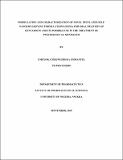UNNSpace Repository
Formulation and Characterization of Novel Pegylated Self-Nanoemulsifying Formulations (Snefs) for Oral Delivery of Gentamicin and its Possible use in the Treatment of Pneumococcal Meningitis
JavaScript is disabled for your browser. Some features of this site may not work without it.
| dc.contributor.author | Umeyor, Chukwuebuka Emmanuel
|
|
| dc.date.accessioned | 2016-06-07T09:50:56Z | |
| dc.date.available | 2016-06-07T09:50:56Z | |
| dc.date.issued | 2016-06-07 | |
| dc.identifier.uri | http://hdl.handle.net/123456789/2357 | |
| dc.description.abstract | The solubility of gentamicin in various formulation vehicles (oils, surfactants and co-surfactants) was determined using the shake flask method. Emulsifying ability of the surfactants for the selected oil was screened. Different SNEF prototypes were developed following the construction of ternary phase diagrams using water titration method. The effect of drug and other additives on the ternary phase diagrams were studied and the selected formulations were optimized. Optimized formulations were characterized by weight uniformity of their capsule shells and visual assessment of their self nanoemulsification. The optical clarity and robustness to dilution of the SNEFs were evaluated. Emulsification time, droplet size, zeta potential, polydispersity index and Fourier transform-infrared spectroscopy were measured. SNEFs were also characterized by scanning electron microscopy (SEM). Apparent viscosities, absolute drug content and drug content efficiencies were determined. Stability studies and octanol/water partition coefficient were evaluated, while in vitro antibacterial studies of the SNEFs and permeation studies were carried out. In vitro anti-pneumococcal study of the SNEFs against S. pneumoniae was done followed by extrapolation of their minimum inhibitory concentrations (MICs). In vivo anti-pneumococcal studies of gentamicin released in the sera and CSF of white albino rats were evaluated. Haematological studies were carried out to measure packed cell volume (PCV), total white blood cells (WBC), red blood cells (RBC) and haemoglobin (Hb) concentrations. Biochemical studies were performed to evaluate alanine aminotransferase (ALT), aspartate aminotransferase (AST), alkaline phosphatase (ALP), bilirubin and creatinine concentrations. This was followed by histopathological examinations of the brain, kidney and liver of the animals. Results were expressed as mean ± SD. ANOVA and student t-tests were performed on the data sets. Ternary phase plots were analyzed using SigmaPlot® 11.0. Permeation calculations were performed with a special Microsoft excel programme. Differences were considered significant for p values < 0.05. Gentamicin produced maximum solubility in soyabean oil, Kolliphor® EL, Kolliphor® P188, and in Transcutol® HP. PEG 4000 and gentamicin reduced the area of nanoemulsion formation in the ternary phase diagrams for the selected systems. The emulsion droplet size was in the nanometer scale. The SNEF capsules had uniform average weight of 300 mg ± 0.7. The SNEFs had good optical clarity with percentage transmittances above 50 % and showed low propensity to drug precipitation, and exhibited rapid emulsification rate (17 – 40 s). FTIR revealed that the structure of gentamicin remained completely intact in all the formulations. SEM micrographs showed smooth and spherical globules. Rheological studies showed decrease in apparent viscosities with increase in shearing speed. Drug content ranged from 36.3 – 99.8 %. Stability studies suggest that the SNEFs were relatively stable over 4 months. Octanol/water partition coefficient ranged from 0.38 – 1.46. In vitro antibacterial studies showed susceptibility in the order: K. pneumonia > E. coli > S. aureus > B. subtilis. In vitro permeation studies of showed overall extended permeation of gentamicin. In vitro anti-pneumococcal study showed MICs of 2.5 – 5 mg/ml. In vivo anti-pneumococcal study of gentamicin in sera suggests that sera from animals administered with batch C (3:1 w/w) gentamicin SNEFs at 7 mg/kg produced good inhibition of the bacteria. The in vivo anti-pneumococcal activity of gentamicin in CSF showed rapid establishment of a biocidal concentration after 30 min. Haematological studies showed increase in PCV, RBC and Hb counts while WBC count and its differentials decreased. Biochemical studies showed decreased ALP and varying AST, ALT, bilirubin and creatinine concentrations. Histopathological findings showed dominant astrocytosis of the brain for gentamicin-loaded SNEFs indicating a breach of the integrity of the BBB. | en_US |
| dc.language.iso | en | en_US |
| dc.subject | Gentamicin | en_US |
| dc.subject | Pneumococcal Meningitis | en_US |
| dc.subject | Oil | en_US |
| dc.subject | Drug | en_US |
| dc.title | Formulation and Characterization of Novel Pegylated Self-Nanoemulsifying Formulations (Snefs) for Oral Delivery of Gentamicin and its Possible use in the Treatment of Pneumococcal Meningitis | en_US |
| dc.type | Thesis | en_US |
